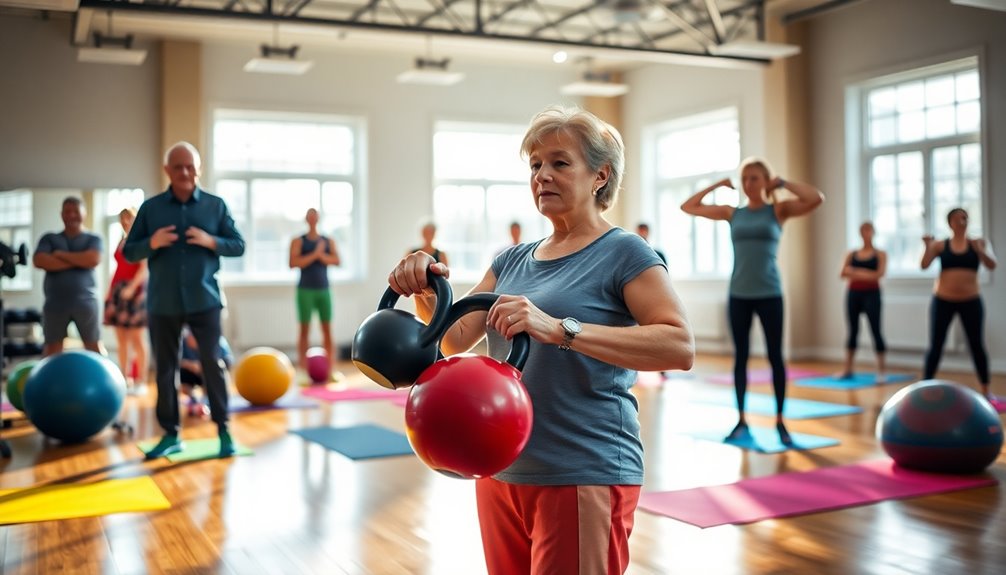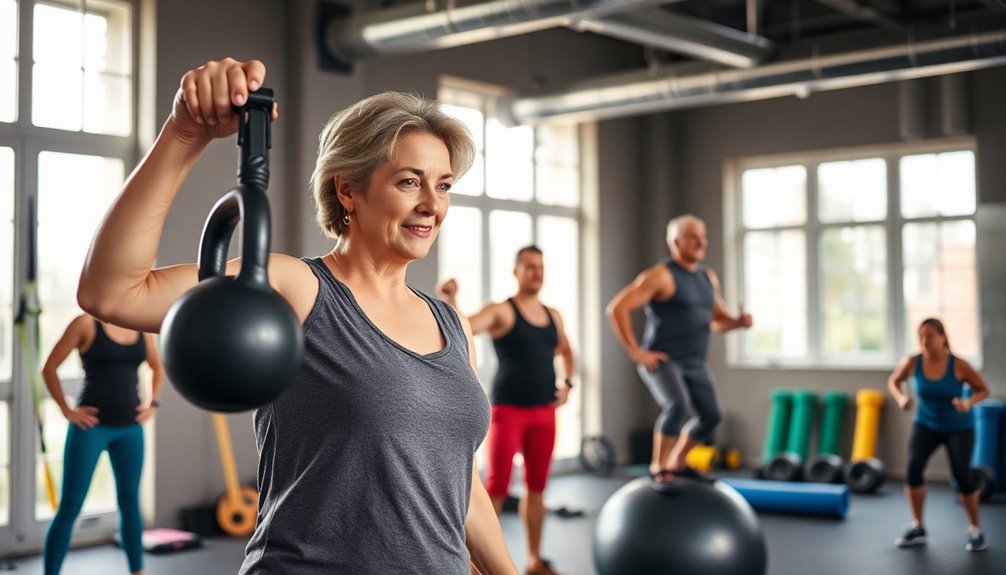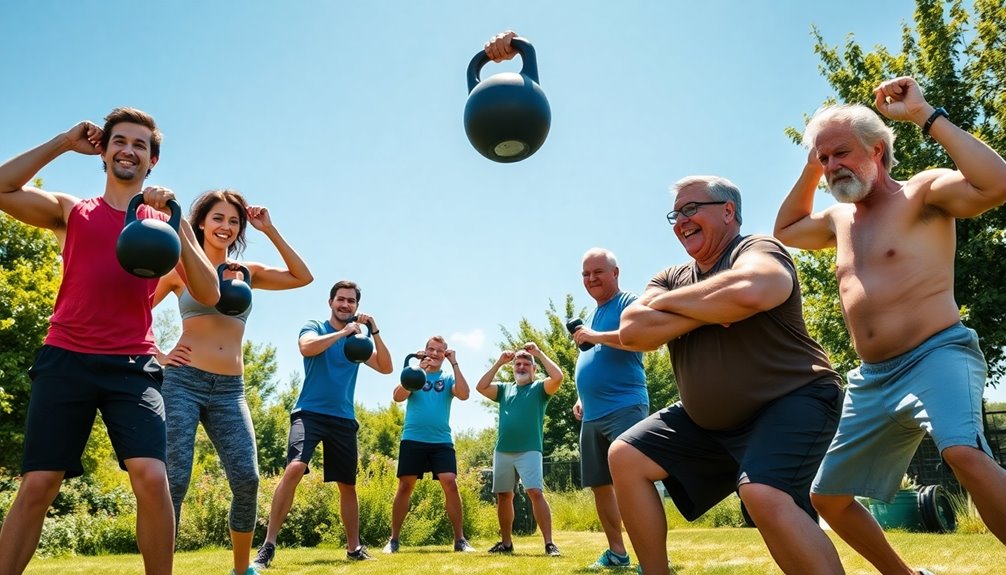Functional strength training helps you build resilience, no matter your age. By engaging in compound movements like squats and lunges, you improve strength, coordination, and balance. This approach mimics real-life activities, making daily tasks easier and safer. You'll not only enhance your physical well-being but also reduce the risk of injuries and chronic diseases. Plus, it can boost your mood and self-esteem as you achieve your fitness goals. Whether you're young or older, the benefits are clear. Stick around, and you'll discover effective exercises and strategies to make the most of your functional training journey.
Key Takeaways
- Functional strength training enhances overall fitness by engaging multiple muscle groups, promoting resilience for daily activities at any age.
- Incorporating exercises like squats and lunges improves balance and coordination, reducing fall risk and supporting independent living as you age.
- Strengthening joints and surrounding tissues through functional movements enhances mobility, aiding recovery from injuries and surgeries.
- Tailored workouts for different age groups foster a strong fitness foundation, supporting mental health and boosting confidence in daily tasks.
- Emphasizing core stability and proper technique in training promotes safety and effectiveness, ensuring longevity in physical activity across all life stages.
Understanding Functional Strength Training

Functional strength training is all about preparing your body for real-life activities. This approach focuses on improving your ability to perform daily tasks, sports, and specific movements that enhance your overall functional fitness. You'll engage in exercises that mimic real-life actions, such as squatting, lifting, and climbing, helping you build strength in patterns that you use every day.
The exercises you'll encounter are typically compound movements that recruit multiple muscle groups, like squats, lunges, push-ups, and deadlifts. You'll primarily use bodyweight or free weights, avoiding machines. This training encompasses six essential movement patterns: squat, lunge, push, pull, bend, and core, which are vital for total body functionality. Regular exercise and mental stimulation also contribute to overall well-being and resilience.
Your training program will be individualized, tailored to your specific goals and health status. It'll integrate flexibility, core stability, balance, strength, and power across various movement planes. Progression is key, so you'll steadily increase the difficulty of your tasks. Plus, feedback—both self-assessment and from a trainer—will help you refine your performance. This adaptable training is suitable for everyone, ensuring you can build resilience and improve your coordination, stability, and strength, regardless of your fitness level. Additionally, incorporating functional movements helps in enhancing your ability to perform daily tasks effectively.
Key Benefits of Functional Strength

Strength training isn't just about lifting weights; it's about enhancing your everyday life. When you engage in functional strength training, you'll notice improved strength and endurance. This type of training strengthens multiple muscle groups simultaneously, increasing your overall muscle mass and stamina. You'll find yourself able to tackle longer and more intense workouts without getting fatigued quickly.
Additionally, functional strength training boosts your balance and coordination. By focusing on the muscles that stabilize your joints, you'll enhance your control and stability. This not only reduces the risk of falls but also improves your overall movement efficiency. Functional movements are essential as they reflect real-life activities, further integrating strength into your daily tasks. Engaging in exercises that mimic real-life activities can lead to even greater benefits in everyday performance.
Injury prevention is another key benefit. Functional strength training helps train your body to move in ways that minimize injury risk during daily activities and sports. By strengthening joints and surrounding tissues, you enhance joint stability and mobility, making it less likely you'll suffer strains.
Improving Everyday Movement Patterns

Everyday movement patterns are essential for maintaining an active and healthy lifestyle. By incorporating functional strength training into your routine, you can notably improve these movements. Here's a quick breakdown of key exercises that mimic daily activities:
| Exercise | Purpose | Daily Activity Mimicked |
|---|---|---|
| Squat | Strengthens lower body | Sitting and standing |
| Hinge | Reduces lower-back pain | Picking up objects from the floor |
| Lunge | Enhances balance and leg strength | Going up stairs |
| Carry | Improves grip strength and stability | Carrying groceries |
| Push | Simulates overhead lifting | Putting away heavy objects |
Engaging in these exercises will enhance your efficiency in daily tasks, making them feel easier and more manageable. Additionally, working on core engagement during these movements can help you maintain better posture and reduce the risk of injury. The beauty of functional training lies in its adaptability; you can modify exercises to suit your fitness level and perform them almost anywhere. By focusing on these movements, you'll promote better mobility, flexibility, and overall functional strength to support your daily life. Functional strength training is beneficial for individuals of all ages, ensuring everyone can improve their physical capabilities. Incorporating Leave No Trace principles not only enhances your workout routine but also fosters a greater respect for the environment as you engage in outdoor training.
Strategies for Injury Prevention

When it comes to staying active and injury-free, implementing effective strategies for injury prevention is essential. Start by strengthening your stabilizing muscles, which support your joints and reduce the risk of injuries, especially in the ankles, knees, and hips. Focus on core stability, as it's vital for maintaining control during movements. Engage in exercises that promote overall strength and mimic daily activities like lifting and twisting. Additionally, incorporating multi-planar movements into your routine can enhance your ability to move safely in various directions. Engaging in activities like water-based yoga can also improve your balance and coordination.
Next, address muscle imbalances. Verify your muscle groups work harmoniously to prevent injuries caused by imbalances. Train to maintain balanced strength between opposing muscle groups, like knee flexors and extensors, which can greatly reduce your risk of injury.
Implement progressive overload in your workouts. Gradually increase exercise intensity and complexity to challenge your body while improving muscle strength. This approach not only delays fatigue but also builds strength relevant to real-world activities.
Lastly, always prioritize proper technique. Use correct lifting methods and full range of motion. Make certain to pre-screen your exercises, use well-maintained equipment, and avoid training when tired or injured. Working out with a partner can also enhance safety. Listen to qualified professionals to stay on track.
Enhancing Coordination and Balance

Building on effective injury prevention strategies, enhancing coordination and balance is vital for overall performance and longevity in physical activities. By focusing on functional movements that mimic daily tasks, you can improve the connection between your brain, nerves, and muscles. Engaging in multi-joint exercises helps you gain better control over your movements, while single-leg workouts challenge your core and stabilizer muscles, essential for maintaining balance. Additionally, functional strength training emphasizes real-life activity movements, ensuring that your workouts translate effectively into daily life. Establishing a trust fund can also provide financial security that allows you to invest in your health and fitness journey without financial stress.
Here are some effective ways to enhance your coordination and balance:
- Incorporate multi-planar movements: Train in all three planes of motion to reflect real-world tasks.
- Use balance equipment: Experiment with balance boards or BOSU balls to increase your challenge.
- Engage in dynamic exercises: Include squats, lunges, and overhead presses to build functional strength.
- Practice on varied terrains: Test your stability by adapting exercises to uneven ground or unpredictable environments.
Functional Training for All Ages

Functional training is essential for individuals of all ages, from children to seniors, as it lays the groundwork for a lifetime of physical well-being. For kids and adolescents, strength training builds a solid foundation of fitness, enhances bone density, and promotes healthy lifestyles. It also improves coordination and balance, making physical activities more enjoyable and fostering social interactions.
For adults, functional strength training boosts metabolism by increasing muscle mass, which helps burn calories even at rest. It lowers the risk of chronic diseases like diabetes and heart disease while supporting mental health by reducing symptoms of anxiety and depression. Additionally, it enhances movement efficiency, making everyday tasks easier, and supports mental health by improving overall cognitive function. Engaging in regular retirement savings options can also provide the financial stability needed to maintain an active lifestyle.
Older adults benefit notably as well. Strength training maintains and builds muscle mass, enabling independence in daily activities. It improves bone density to reduce the risk of osteoporosis and fractures, while also enhancing balance to prevent falls and injuries. Furthermore, engaging in physical activity positively impacts cognitive function, keeping the mind sharp. Additionally, social engagement and peer support often accompany regular exercise routines, fostering a sense of community among older adults. This social aspect can further enhance mental well-being, as individuals share experiences and knowledge about health-related topics, including what to expect from hearing aid forums. By participating in these discussions, seniors can gain valuable insights into managing hearing loss, ultimately leading to a more informed and empowered lifestyle.
Practical Applications in Daily Life

Functional Strength Training: Build Resilience at Any Age
Practical Applications in Daily Life
Strength training directly impacts your daily life by enhancing how you perform everyday tasks. When you incorporate functional strength training, you'll notice improvements in various activities, making them easier and less tiring. This training not only boosts your strength but also enhances balance and coordination, helping you move more confidently through your day. Additionally, engaging in physical activities contributes to emotional regulation, which is essential for managing stress and maintaining mental well-being.
Here are some practical applications you can expect:
- Lifting and carrying: Effortlessly manage heavy suitcases or grocery bags without straining.
- Playing with kids: Keep up with energetic children, enhancing your enjoyment and engagement.
- Preventing injuries: Strengthening your muscles and connective tissues reduces the risk of falls and injuries, helping you develop muscle resilience.
- Improving mobility: Experience greater flexibility and range of motion, making tasks like bending, reaching, and twisting easier.
With these benefits, you'll find that everyday movements, whether it's sitting, standing, or maneuvering stairs, become smoother and more efficient. As you build resilience through functional strength training, you'll improve your overall quality of life, allowing you to maintain independence and enjoy activities without discomfort. So, embrace strength training, and watch your daily tasks transform!
Effective Exercises for Functional Strength

When it comes to enhancing your everyday performance, incorporating effective exercises into your routine can make a significant difference. Start with squats to strengthen your quadriceps, hamstrings, and glutes, which help you stand up from a chair or lift objects from the ground. Lunges are great for improving stability and strength, making climbing stairs or bending down easier.
Box step-ups engage key leg muscles and boost your balance, essential for maneuvering stairs or entering vehicles. To improve mobility, try the prisoner get-up, which helps you get down and back up using only your lower body. Additionally, having survival gear on hand can be beneficial in emergencies, ensuring you're prepared for unexpected situations.
For upper body strength, pull-ups and push-ups are invaluable, targeting your back, chest, and arms for everyday tasks. Dumbbell rows also enhance your pulling strength for opening heavy doors. Functional training is particularly beneficial as it improves strength, endurance, and overall fitness levels, which are crucial for completing daily activities.
Don't forget core and full-body exercises like the farmer's walk and kettlebell swings, which improve grip strength and overall endurance. Plank bird dogs enhance balance and stability, while burpees challenge your strength and agility. By including these exercises, you'll build functional strength that translates into real-life benefits.
Combining Functional Training With Other Workouts

Building on the foundation of effective exercises for functional strength, integrating functional training with other workout styles can considerably enhance your overall fitness. Combining these approaches not only improves strength but also builds endurance, flexibility, and balance. Here are a few strategies to get you started:
- Pair muscle groups: Combine upper and lower body exercises to maximize efficiency, like squatting while incorporating shoulder presses.
- Circuit workouts: Structure your routine with circuits of 5 exercises, minimizing rest between them to keep your heart rate up and increase stamina. Engaging your core during these exercises is crucial for injury prevention.
- Use varied equipment: Incorporate free weights, resistance bands, or even household objects to add resistance and challenge your muscles.
- Incorporate cardio: Mix in aerobic activities, such as running with bodyweight exercises, to boost fat burning and improve your overall fitness.
Long-Term Benefits of Functional Strength Training

Functional strength training offers numerous long-term benefits that can considerably enhance your overall well-being. By committing to this form of training, you're not just building muscle; you're investing in a healthier future. You'll notice improved muscle strength, particularly in your legs, which boosts your metabolic rate and enhances your walking performance. This means you'll move with greater ease and confidence in your daily life, while also benefiting from herbal alternatives for botox-like effects that can enhance your skin's elasticity over time.
Here's how functional strength training impacts different aspects of your life:
| Benefit | Description | Emotional Impact |
|---|---|---|
| Improved Mobility | Increases flexibility and joint range of motion | Feel more agile and free |
| Injury Prevention | Reduces risk of falls and joint injuries | Gain peace of mind |
| Enhanced Mental Health | Boosts mood and self-esteem | Experience joy and confidence |
| Overall Health | Lowers chronic disease risk | Live life to the fullest |
As you engage in functional strength training, you'll reap these benefits, leading to a healthier, more active lifestyle. You'll feel empowered, capable, and ready to tackle life's challenges, no matter your age. Engaging in compound exercises as part of your training can significantly enhance your overall strength and functionality.
Frequently Asked Questions
Can Functional Strength Training Help With Weight Loss?
While traditional weight loss methods focus solely on calorie restriction, functional strength training actively engages your whole body, boosting metabolism and enhancing calorie burn. You'll not only shed pounds but also build muscle and improve your overall fitness. By incorporating dynamic movements that mimic daily activities, you make workouts enjoyable and effective. Plus, it's adaptable to your fitness level, ensuring you stay challenged and motivated on your weight loss journey.
How Often Should I Perform Functional Strength Training?
You should aim to perform functional strength training about 2-3 days a week if you're a novice or intermediate. This frequency allows for proper rest and enhances your muscle endurance. If you're more advanced, consider training 3-5 days per week to target muscle groups more frequently. Just remember, balancing intensity and recovery is key to avoid burnout and guarantee progress. Listen to your body for best results!
Is Functional Strength Training Suitable for Seniors?
Did you know that regular strength training can reduce the risk of falls in seniors by up to 30%? Yes, functional strength training is definitely suitable for seniors! It helps improve muscle mass, bone density, and overall mobility, making daily activities easier and safer. By participating in tailored programs, you'll enhance your independence and maintain your physical abilities. Just be certain to get guidance from a qualified trainer to guarantee safety and effectiveness.
What Equipment Do I Need for Functional Strength Training?
For functional strength training, you'll need a few essential pieces of equipment. Start with kettlebells and resistance bands for versatile workouts. Incorporate weighted balls and sandbags to enhance strength and stability. Battle ropes are great for cardio and dynamic movements. If you want to focus on mobility, consider using suspension trainers and ab wheels. Choose portable options to easily train at home or outdoors. This setup will help you build strength effectively.
Can I Do Functional Strength Training at Home?
Imagine transforming your living room into a personal gym! Yes, you can absolutely do functional strength training at home. With just dumbbells and an exercise mat, you've got everything you need. Minimal space is required, so you can easily fit in a workout. You can even use bodyweight exercises if you prefer. By dedicating just 20-30 minutes, you'll build strength and endurance while enhancing your ability to tackle daily tasks with ease.









